2015

We moved into the facility in August of 2015.
Learn about the remarkable history of Local 455.
Local 455 was established on November 5, 1904, when President William Merrick and Secretary Treasurer L.W. Tilden inked their signatures on the United Association Charter. Although we started with 27 members, by 1908 our count had dropped to eight. But in a few short years, with the rise of larger industrial projects, including many for Northern States Power Utility, the trend began to reverse.
Despite a sharp decline in union membership nationwide, our membership remained strong in the 1920s. Records show this can be attributed to the construction of the NSP High Bridge Power Plant in 1924, as well as the Ford Motor Assembly Plant in 1925.
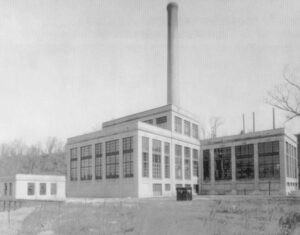 In the 1930s, the Great Depression brought about a tremendous amount of unemployment, causing our membership to drop from 76 to 68. Nevertheless, Local 455 members held onto jobs at several well-known Minnesota landmarks, including the Whirlpool plant, Schmidt brewery, Hamms brewery, and Waldorf Paper Company, to name a few.
In the 1930s, the Great Depression brought about a tremendous amount of unemployment, causing our membership to drop from 76 to 68. Nevertheless, Local 455 members held onto jobs at several well-known Minnesota landmarks, including the Whirlpool plant, Schmidt brewery, Hamms brewery, and Waldorf Paper Company, to name a few.
Throughout the 1940s, World War II brought a great deal of work to our jurisdiction, including the Arden Hills Arms Plant. Between this project, the groundbreaking of 3M’s main plant, and other government contracts, our members stayed busy. In 1944, we registered a set of apprenticeship standards with the state, which made our longstanding apprenticeship program official. On July 25, 1947, following a national trend of increasing market share and membership, we merged with metal trades workers and added Ramsey, Washington, and Dakota counties to our jurisdiction.
The Korean conflict and work at power plants and breweries kept our members employed during the first half of the 1950s. We also began work at Great Northern Oil Refinery in Pine Bend. By the end of the 1950s, union representation in the U.S. was at an all-time high with 32 percent of the non-agricultural labor force holding union membership. In 1957, we established the Local 455 credit union to serve our 492 members.
Work in our jurisdiction remained in steady through the 1960s, partly thanks to the Kennedy administration and the flood of 1965. One of the largest projects we worked on was the clean up of Metro Waste. As a result of wage increases, our members decided to start investing in important fringe benefits such as the Pension Fund, Health & Welfare Fund, the Vacation Fund, and apprenticeship training.
In 1976, many Local 455 members enjoyed the opportunity of a lifetime in the construction of the Alaska Pipe Line. Throughout a four-year period, we had 135 pipefitters on the project. By the end of the 1970s, our membership had reached 831.
The 1980s saw several significant projects for Local 455, including the Koch Oil Refinery, Ford Plant expansion, District Energy, and Prairie Island Nuclear Power Plant. In 1983, we were awarded the Waldorf Paper Steam Line project, which required 101 of our steamfitters and went on record as the country’s longest steam line. Between 1987-89, however, Local 455, along with local unions throughout the country, experienced unemployment rates between 10 to 15 percent. Despite a lack of work, our membership reached 959 as the decade came to a close.
Throughout the mid-1990s, we were able to keep almost all of our members employed on local projects, including work at the Koch Oil Refinery, Ashland Oil Refinery, and Prairie Island site, to name a few. In 1994-95, the large capital projects in our jurisdiction came to an end, and many of our members traveled to other parts of the country for work. But thanks to projects such as the University of Minnesota power plant, the turbine rebuild at Prairie Island, and large commercial projects in St. Paul, we were able to keep our 1,151 members employed in the late 1990s.
Work started off strong in the early 2000s with projects at District Energy sites, the Ramsey County Jail, the Federal Bureau of Apprehension, and major expansions at Flint Hill’s oil refinery. The remainder of the decade, however, was marked with varying levels of unemployment as a result of the Great Recession.
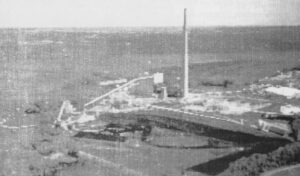 In 2012, after things had turned around, we acquired Hillcrest Investments. This acquisition gave Local 455 ownership of the largest privately owned tract of land in St. Paul. In 2014, after deciding to move our training in-house, we purchased a 64,000-square-foot building on L’Orient Street in St. Paul and remodeled it to become a 100,000-square-foot office, meeting hall, and training and certification center.
In 2012, after things had turned around, we acquired Hillcrest Investments. This acquisition gave Local 455 ownership of the largest privately owned tract of land in St. Paul. In 2014, after deciding to move our training in-house, we purchased a 64,000-square-foot building on L’Orient Street in St. Paul and remodeled it to become a 100,000-square-foot office, meeting hall, and training and certification center.
Eager to move from our rented space, we took occupancy of our new facility in 2015. Since then, we have continued to set the standard in training while providing the highest skilled steamfitters/pipefitters for the job.

We moved into the facility in August of 2015.
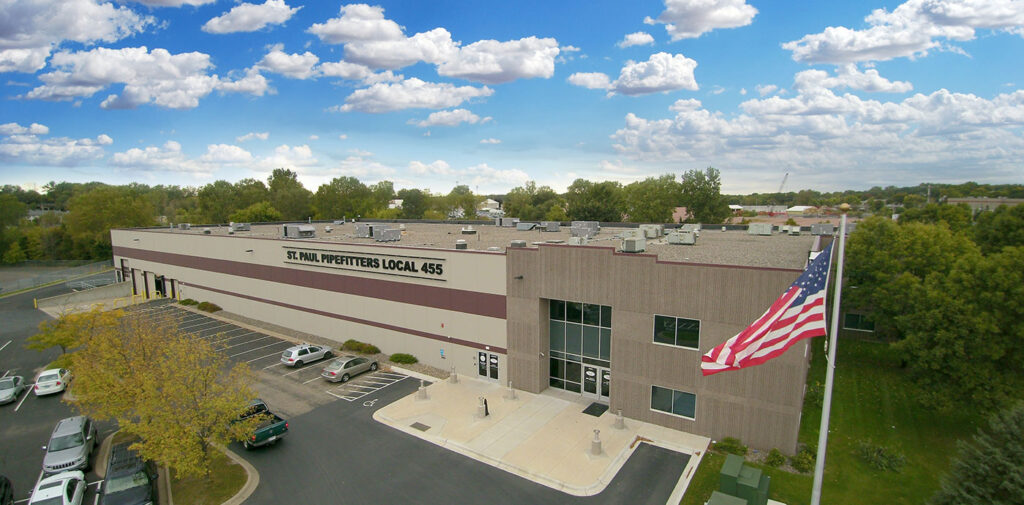
Purchased and started renovating our new building in 2014
Pipe Fitters had very lean years from 2008 to 2012 due to the “great recession” we had very high unemployment and very little work on new projects. Light commercial work with the occasional Spring turnaround and Fall Shutdowns was all we had to keep our membership working. We established the Employee’s Assistance Fund to help ease a little of the financial burden our struggling members.

The boom carried through the end of 2002 and then everything dried up. All of 2003, and the first quarter of 2004, has been terrible for employment. Hopefully things will get better soon. Only time will tell. The election coming up this fall will have a lot to do with the future of all working class people in the United States. Currently, total membership is at 1,251. Dues are $83.00 a month. The total package is $44.60 per hour.
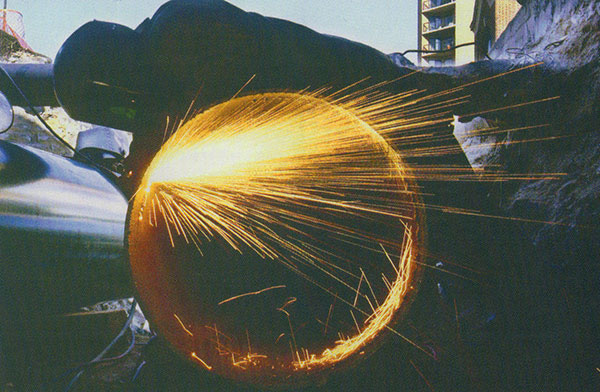
This picture is typical of the continuing work being done in the streets on the District Energy cooling system in downtown St. Paul. Even though the cooling system was started in 1988, it still continues to expand. It has provided work for the members of Local 455 every year since.
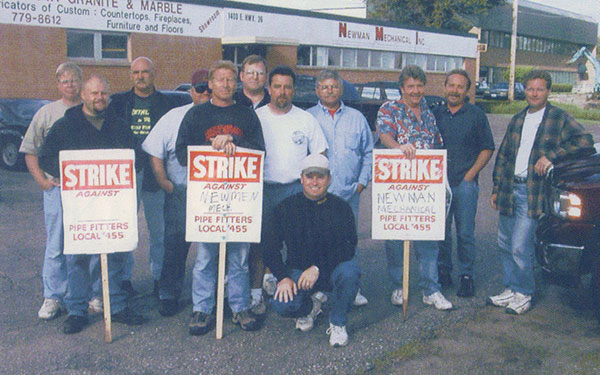
In March of 2002, the first meeting took place to negotiate the new contract for May 1st. The negotiations continued until it was obvious no agreement was going to be reached. Local 455 voted to go on strike for economic reasons. We continued to meet with the contractors with very little success. Four weeks into the strike, the UA was brought in to assist us in the negotiations. An offer was made to the contractors by the UA. This was rejected by the contractors. The strike continued for almost eight weeks before a settlement was reached. It should be noted that we worked without a contract for one week, to bargain in good faith, to no avail.
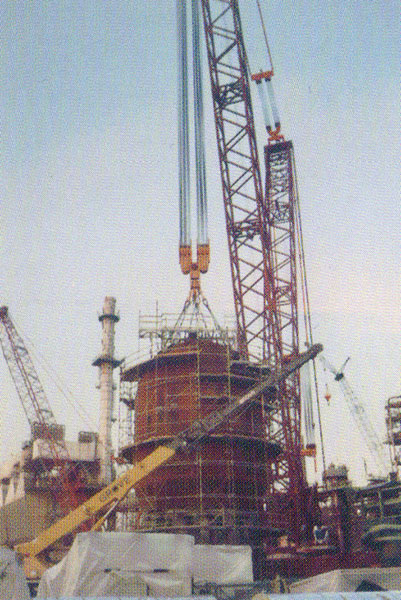
In the years 2000, 2001 and 2002, things were still pretty good. The District Energy Biomass Power Plant provided quite a bit of work for our members. The District Energy River Crossing to the Westside opened up some work for us. The Ramsey County Jail and the Federal Bureau of Apprehension projects were under construction.
The Co Generation at 3M Chemolite in 1996, the turbine rebuild at Prairie Island in 1997, the power plant at the U of M in 1997 and the Incinerator Project at the 3M Chemolite in 1998 were all large projects that employed the Pipefitters Local 455 in the late 1990s. From 1997 into the year 2000, the City of St. Paul was busy with some very large commercial projects. Under construction were the River Center Convention Hall, the St. Paul Science Museum, Lawson Software and the Xcel Wild Arena. By the end of 1999, the membership was up to 1,151. The dues were $71.00 a month. The total package was $36.18 per hour.
Brought an end to the large capital projects in the jurisdiction of Local 455. Many of our members had to travel out of town to find work. We had people all over the country. Some of the locals in other parts of the country, from which we had hired their members, returned the favor by putting our members to work on their jobs.
Along with the Clean Fuels job still being worked on in 1993, Ashland Oil Refinery had a Hydrogen Unit started. There was also some District Energy work being done in the street.

In 1992, Prairie Island also had the cooling water project going. The Koch Oil Refinery started the Clean Fuels unit. This project put many members from around the country to work.

In 1991, we had enough work to keep almost all the members working. The Prairie Island site had the SBO project underway.
The end of 1989, membership was up to 959. The dues were $55.00 a month. The total package was $24.71 per hour.
Inevitably, in 1988, with the election of President Bush, things did get worse. All around the nation unions were being challenged. With the decline of industries that were highly unionized, such as the steelworkers, autoworkers and rubber industry workers, unions lost many of its members. Global competition intensified. Consequently, the construction trades suffered as well. Local 455 had been experiencing a lot of unemployment during the years 1987-1989. During that three-year period, we consistently had 10% to 15% unemployment.

In 1987, the threat of Brown & Root at Koch Oil Refinery was very real. Local 455 had quite a bit of employment. We all knew something had to be done to maintain a presence at that refinery. Business Manager Tony Rohrer was forced to make an unpopular decision of reducing the taxable wages to 95% for journeymen only. The Local continued under that wage reduction for over five years.
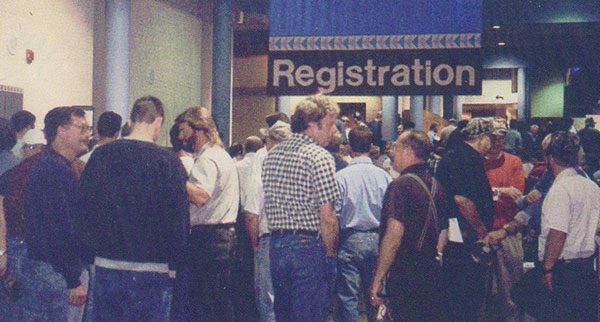
In 1986, the first HEATS ON project occurred. It has been an overwhelming success. The following year the Minneapolis Pipefitters Local 539 made it a joint effort. In 1986, Koch Oil Refinery started another new unit, so for the most part, work was still good for us. Even with the strong efforts of President Regan to destroy as many unions as possible, Local 455 managed to stay strong.
Brought the expansion to the Ford Plant. The Prairie Island Nuclear Power Plant had work going on as well.

Brought the Waldorf Paper Steam Line project and the District Energy Heating System project to the area. Both of these projects worked a lot of overtime. The steam line was 5.25 miles long. Local 798 tried to claim it under the pipeline jurisdiction, but because it was a high-pressure steam system, the State High Pressure License was required. The job was awarded to Local 455 steamfitters. 101 Steamfitters worked on that job. It is on record as being the longest steam line in the United States. The District Energy job was also very unique. This system replaced all the boilers in the buildings in the St. Paul downtown area. High pressure/high temperature hot water was supplied from a central heating plant in the downtown area to everyone who signed onto this system. This created a tremendous amount of work for the Local.
In 1981, Litwin started a project at Koch Oil. Also in 1981, Ashland Oil had a big job underway. Foster Wheeler was on that sight.

With the election of President Ronald Reagan, the working class people of America knew they were in for hard times. Ironically, for the Pipefitters in St. Paul, the workload in the 1980s was pretty good. In 1980, we still had the Mid Valley project going at Koch Oil Refinery.
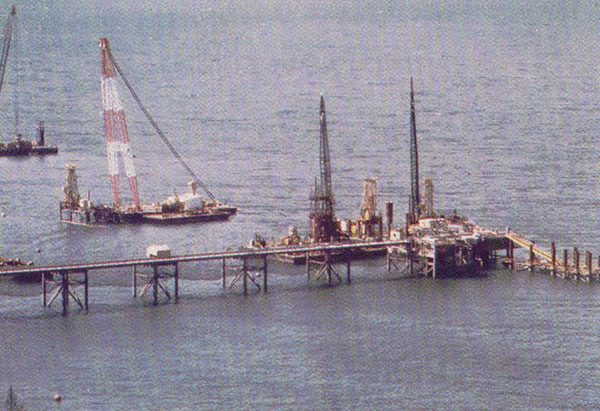
Brought about the opportunity of a lifetime for many of us in Local 455–the Alaska Pipe Line started construction. Just about everyone in the Local wanted to go to Alaska. It was nonstop money for four years. During that four-year period, Local 455 had 135 pipefitters working on on that project. It was a big break for our members to get ahead financially. Local 455 started a down hand procedure welding course on Saturdays to help the members improve their skills so they could pass the hire on welding tests. With the construction of the Sherco Power Plant site and the Alaska Pipe Line underway, other members of Local 455 now had the opportunity to work on projects in town. By the end of the 1970s, membership had risen to 831 members. The dues were $32.00 a month. The total package in wages for the pipefitters was $14.42 per hour.

In 1975, construction of the NSP Sherco Units 1 and 2 in Becker, MN was awarded to Local 455. This was a huge boost to the State of Minnesota for the construction trades, and especially Local 455, because of the high unemployment.
The year 1970 brought about the Occupational Safety and Health Act (OSHA). Union support was instrumental in the passing of this law. Things still looked good for the first couple of years. Then President Nixon was elected into office and things took a turn for the worse. Difficult economic conditions prevailed for many working people in our nation, including the Pipefitters of Local 455. The Prairie Island Plant was still under construction.

In 1968, the Pipefitters were called to man the Prairie Island Nuclear Power Plant Project.

In 1967, Red Wing Local 290 was merged with Local 455. As the price of doing business increased, so did the monthly dues. In 1960, the dues were $10.00 a month. By the end of the 1960s, the dues had increased to $18.55 a month. The total package was $6.88 per hour. By the end of the 1960s, total membership was up to 576.

In 1966, the Allen S. King Power Plant began construction. It was the highest emission stack of all the power plants in NSP system. The stack is 830′ high.
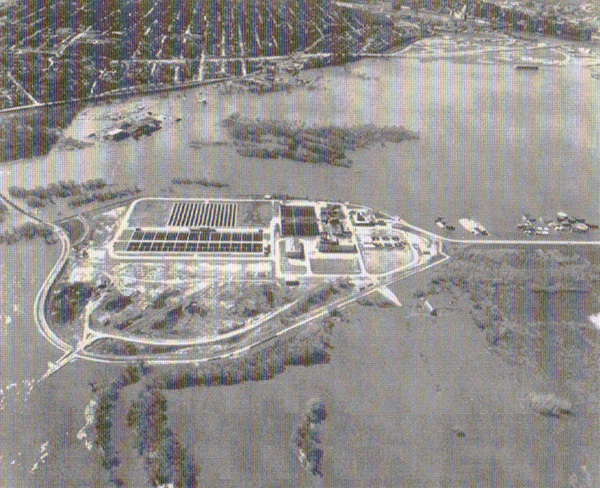
The membership started thinking about how important fringe benefits might be. Wage increases were good enough to start investing in their future. In 1960, ten cents per hour went into the Pension Fund In 1962, thirteen cents per hour went into the Health & Welfare Fund In 1962, seventeen cents per hour went into the Vacation Fund IN 1962, one cent per hour was allocated for apprenticeship training
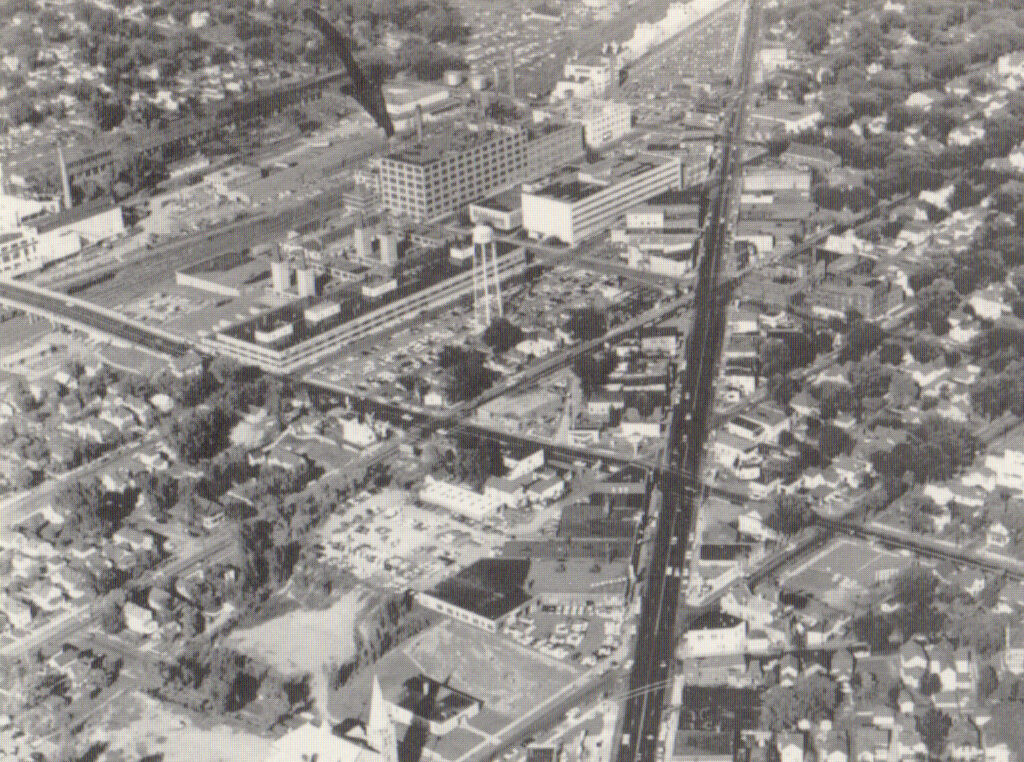
With the presidency being held by John F. Kennedy, the union movement was doing great. Membership was increasing; people had jobs; everything was going great. Local 455 increased its membership to approximately 510 members. Jobs were breaking all over town. There were huge projects being let at Metro Waste. After the flood of 1965, the Metro Waste was in terrible shape. There was so much raw sewage spilled into the tunnels the pipe fitters had to receive tetanus shots and wear rubber suits to clean up the site. The 3M Research Center had started its expansion projects in the early 1960s. This added many jobs for Local 455. Both Northwestern and Great Northern Refineries had enough work to bring in travelers to work on those sites.
The Pipefitters Credit Union was established on May 1st, 1957. There was no hourly contribution to the credit union. It was strictly an institution to start a savings account and apply for small loans. The credit union was founded by Brothers John E. Mueller, Eugene R. Connelly, Robert J. Vacanti, Richard A. Pinska and Raub L. Tiffany. By the end of the 1950s, union representation in the United States was at an all time high. Thirty-two percent (32%) of the non-agricultural labor force were union members. The total membership in Local 455 was 492. The dues at this time had risen to $5.50 a month.
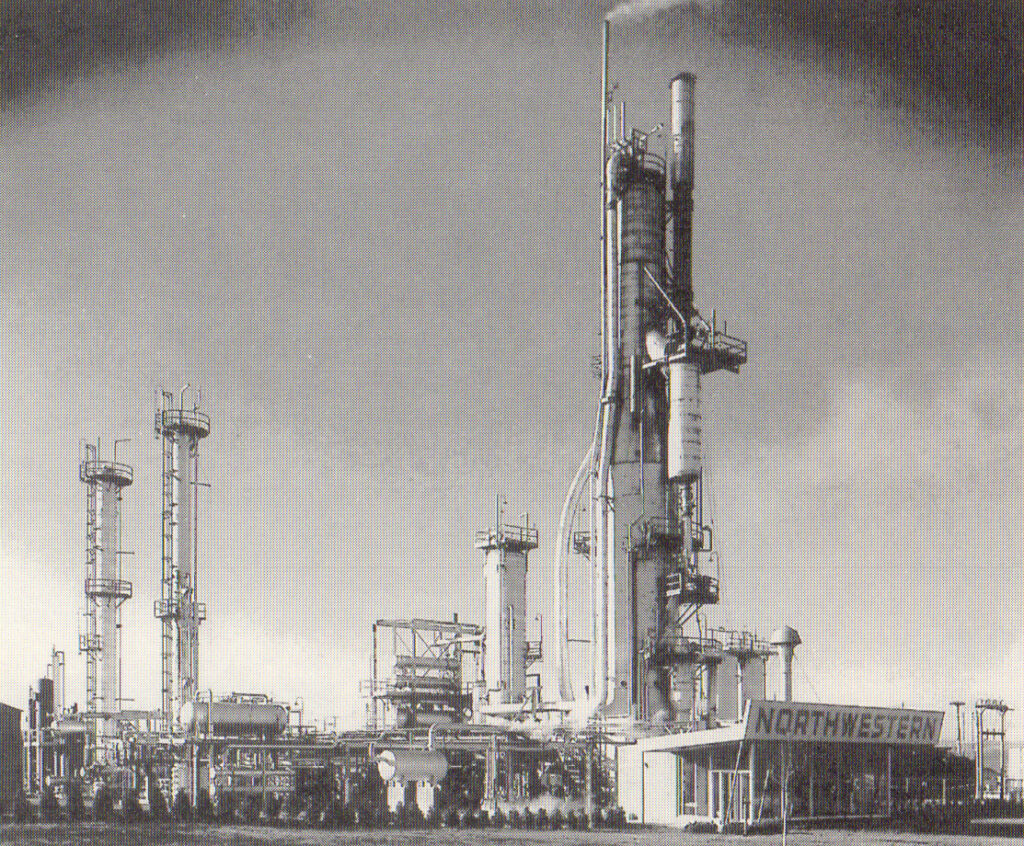
The Erickson Brothers founded Northwestern Oil Refinery in 1939. The refinery was shipped to us from the state of Texas and reassembled in St. Paul, Minnesota. It was a very small unit and not many fitters were on the project. The picture you see gives you an idea of what it looked like in 1955. Also in the fall of 1954, work had started on the Great Northern Oil Refinery (Pine Bend). That Refinery started refining its product in 1955.
In the first half of the 1950s, the members of Local 455 still had a fair amount of work. The Korean conflict kept strong employment at the Arden Hills Arms Plant. Also, all four units of the Black Dog Power Plant were built in the 1950s. In the second half of the 1950s, the work slowed down some. This was partly due to the Republican Administration (President Eisenhower). We did have some work at the Hamms and Schmitz Breweries, Waldorf Paper Co. and 3m Research. In 1955, our health coverage had begun. Gerald O’Donnell was one of the founding trustees. The contribution at that time was .075 cents per hour. In 1949, the City Gas License became law. In 1926, the City Oil License became law. In 1951, the City City Steam License became law. In 1954, the City Refrigeration License became law.
In 1947, organizing and merging of local unions was a common strategy to increase the market share and increase membership. Local 455 merged with the metal trades workers on July 25, 1947. At that same time, the size of the local increased by adding the counties of Ramsey, Washington, and Dakota. Total membership of Local 455 at this time was 150.
Even though the Pipefitters did have apprentices in those early years, it wasn’t until February 29, 1944 that Local 455 had a set of apprenticeship standards registered with the state of Minnesota. This was due greatly to the efforts and foresight of Gerald O’Donnell, Business Manager.
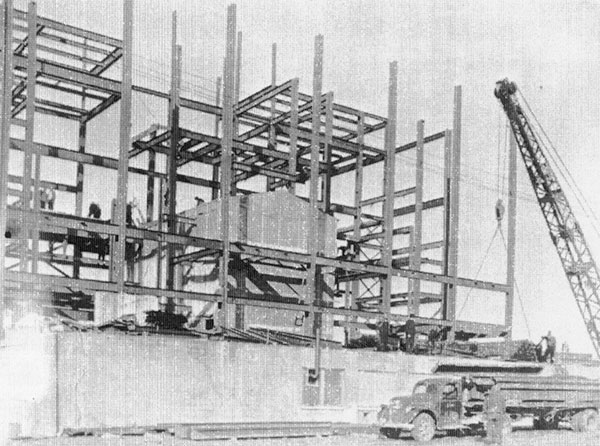
In the 1940s, things got a little better. The Second World War brought a lot of work to our jurisdiction. Construction of the Arden Hills Arms Plant created a lot of work for the Steamfitters in Local 455. Also, the beginning construction of the 3M main plant was coming out of the ground. These two projects, along with other government contracts, kept our local employed throughout most of the 1940s. During the Second World War, union membership in the United States had risen to about 8.5 million. During that time, most unions took no strike pledges because of the war.
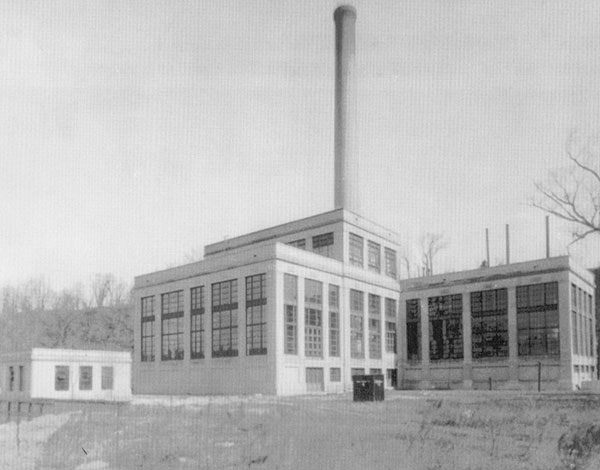
The High Pressure Steam License was adopted in 1937 by John Barrett. Gerald O’Donnell took office as the Business Manager in 1938 and held that position for 30 years. By the end of the 1930s, membership had dropped to 68 members.
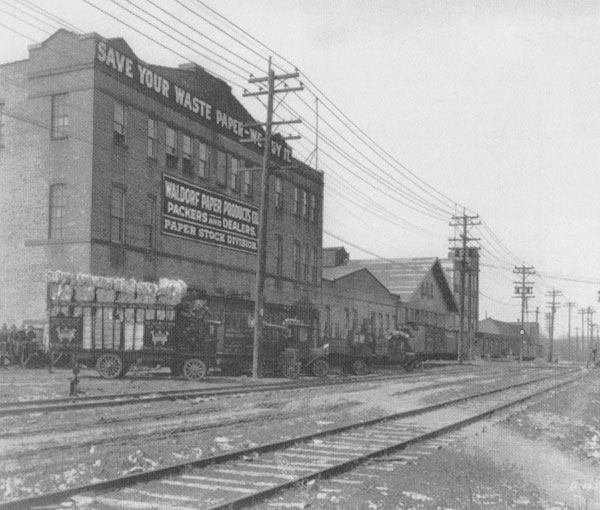
In the 1930s, there was not much to be happy about in the union movement. There was a tremendous amount of unemployment. The bright spots in the union movement were in the political arena. Laws such as the NLRA, better known as the WAGNER ACT, were made into law in 1935. The work that was being performed by the Steamfitters during that time was at the Whirlpool Plant, Hamms Brewery, Schmitz Brewery, Minnesota Mining and Manufacturing Co, Brown & Bigelow Printing, West Publishing Co, Waldorf Paper Co. Just to name a few.
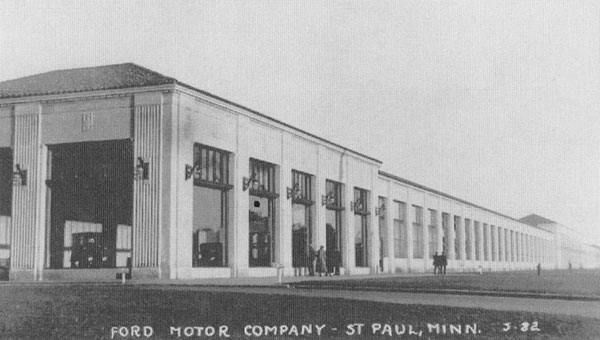
Was the first union meeting to be held at the St. Paul Labor Temple located at 418 Franklin St. Total membership at this time was 76.
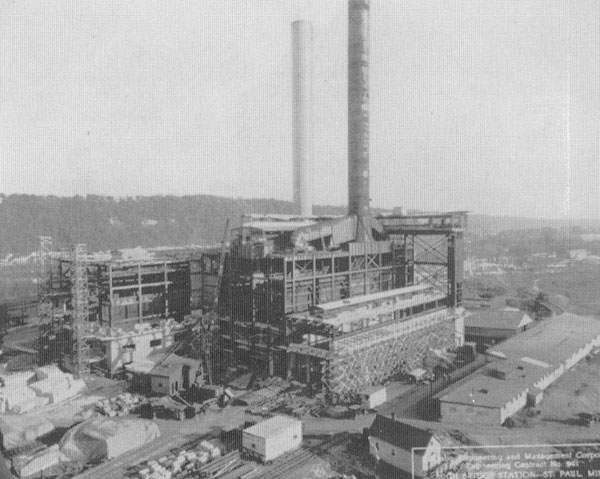
In the decade of the 1920s, Unions suffered a decline in membership nationwide. In fact, the total membership during this period went from 5.1 million to 3.5 million members. But locally the record shows that Local 455 was able to maintain its membership. This was widely due to the construction of the NSP High Bridge Power Plant, which started in 1924 and also the start of construction of the Ford Motor Assembly Plant in February of 1925.

In 1915 thru 1919, approximately one third of new employees in the United States were represented by unions. In fact, a record was set for the number of strikes nationwide and Local 455 participated in strike action during this time period as well. Total Membership for Local 455 was nine members.

In October of 1914, the cash sheet indicates Fred Siegel was Financial Secretary and A. Holland was President of the Union; it also listed Mark McGrath as the Business Agent. Fred Siegel, better known as Buggsy Siegel, believed so strongly in the union that he actually mortgaged his house to fund the operation of the union.

In March of 1913, the records indicate that J. J. Foley was President of Local 455. In 1913, the unions struggled to have a strong identity. One of the accomplishments for which the unions were successful, along with the help of the Democratic Labor Party, was the creation of the first things they did was establish the minimum wage law. Another significantly important bill passed by the state Legislature was the Workers Compensation Bill to protect people who were injured on the job
In June of 1912, Robert Morgan was referred to as the Business Agent. This is the first time the term Business Agent was mentioned. Not known to many of our members, Local 455 Steamfitters organized a Helpers Local 402. The statement was recorded to say ‘new members will be added from time to time in sufficient numbers to fill the demand as needed.’
In October of 1911, Ben Weersing was listed as Secretary Treasurer. That also was the start of the larger industrial projects. Northern States Power (NSP) Utility was one of those industries. From 1908 to 1912, the union meetings were held on the first and third Tuesdays of each month at the Federation Hall located at 309 Wabasha St.

In March of 1907, John Pastoret was listed as the Recording Secretary.

In December of 1904. Frank Odell was listed as the Recording Secretary.